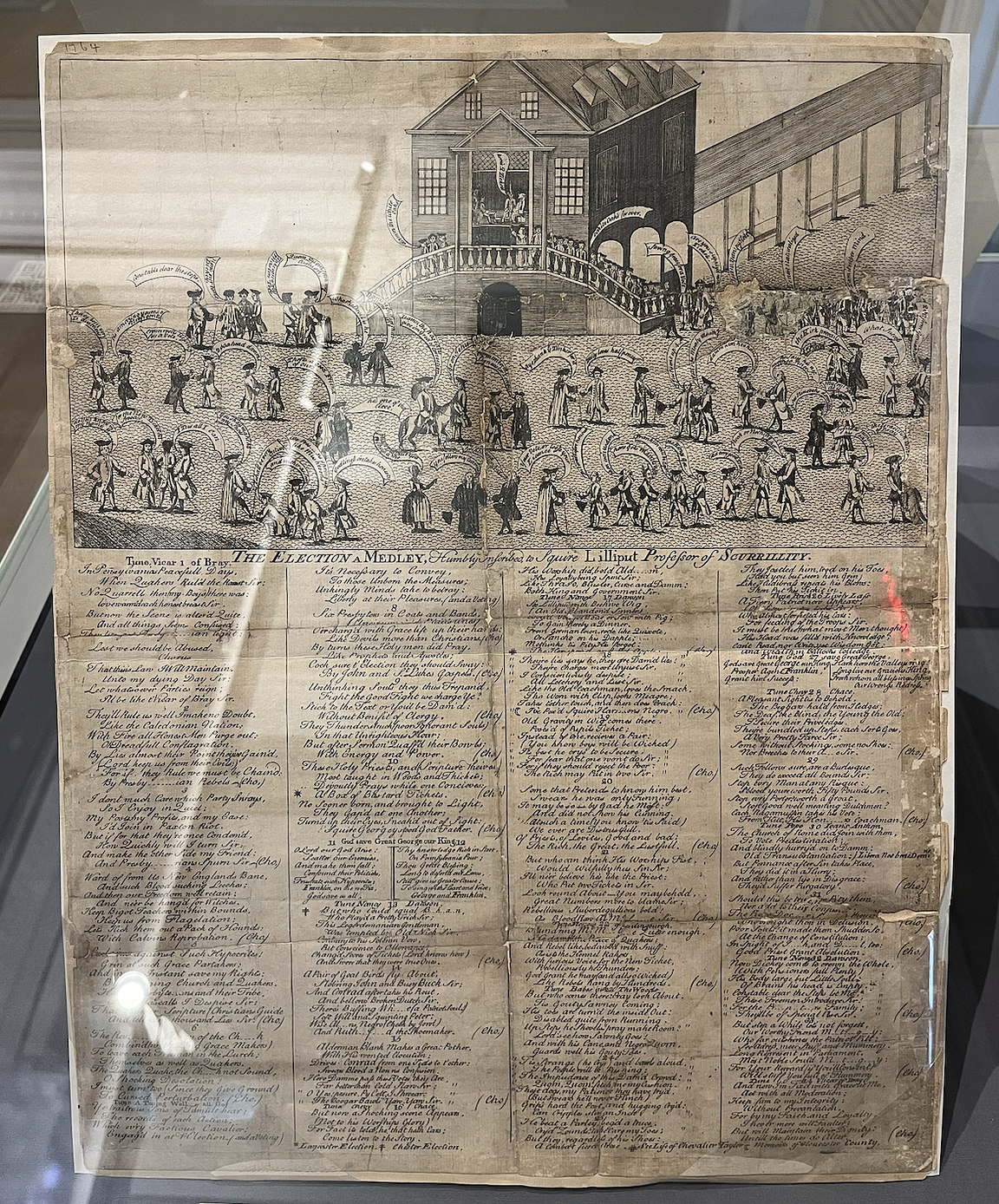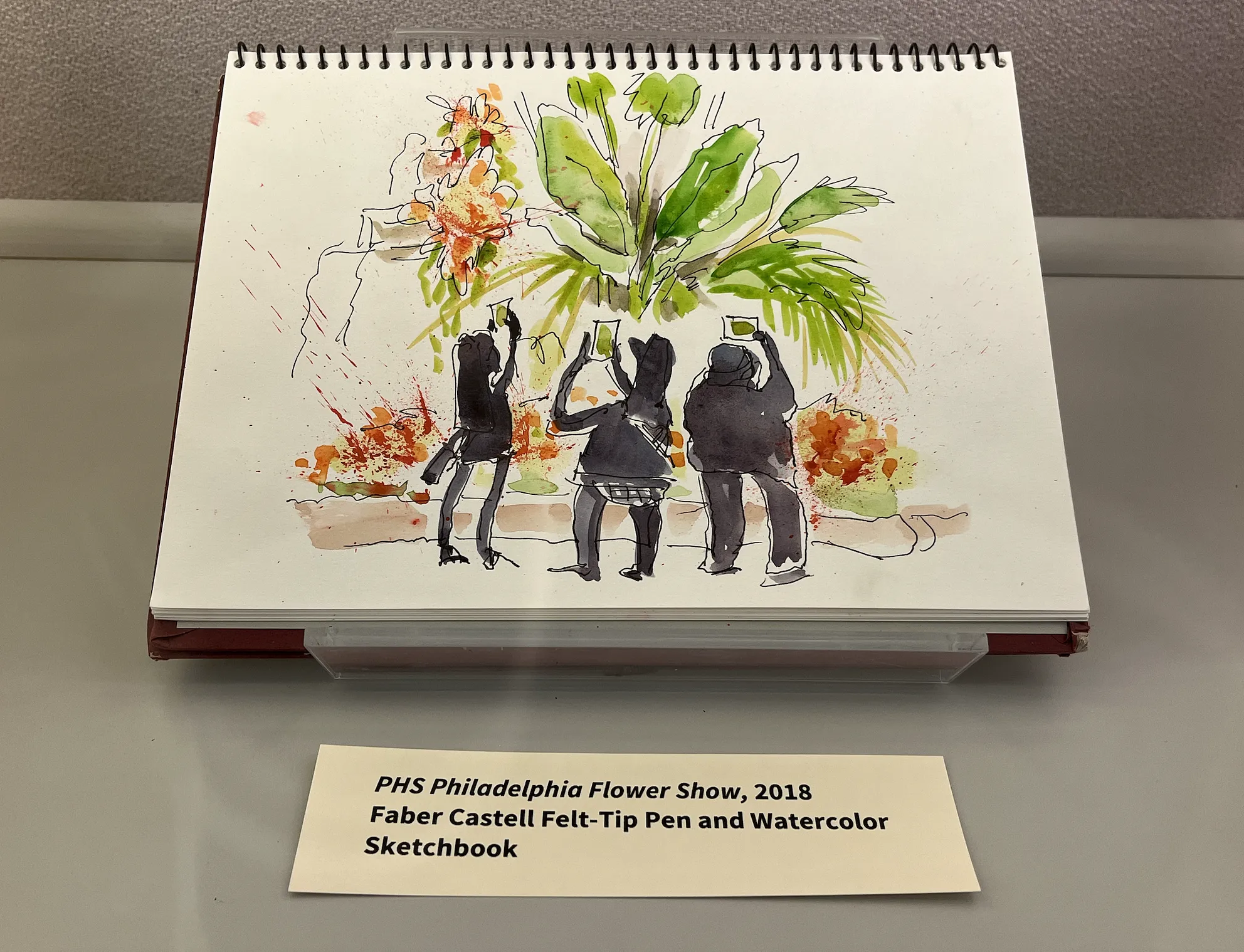Cartoons as Political Speech in Colonial and Contemporary America
Historical Society of Pennsylvania
1300 Locust St.
Philadelphia
Through Aug. 2, 2024
You’re looking at a black and white cartoon of ghoulish men with electrocuted wigs cheering as two of their own face off with what look like a pair of tongs and a giant splinter. What do you caption it?
What about another cartoon of a porcupine with a human face writing about discord while a crowned lion throws a temper tantrum, a woman weeps, and a devil spews upside down calligraphy into the air?
Both of those scenes are on display at the Historical Society of Pennsylvania, which is currently welcoming walk-ins to the free exhibit, Cartoons as Political Speech in Colonial and Contemporary America.
If you’re a cartoonist etching political events taking place in 1798, the answer to that first question would be “Congressional Pugilists.” Actually, that’s the title of the cartoon, which dramatically depicts a real-life incident that ensued after U.S. Reps. Roger Griswold (a Federalist) questioned the valor of Matthew Lyon (a Democratic Republican) on the floor. Lyon then spat tobacco juice in Griswold’s face. When Lyon was not subsequently removed from the House, Griswold attacked him with a wooden cane while Lyon defended himself with fireplace tongs.
Something closer to a caption is the four-line poem underlying the print: “He in a trice struck Lyon thrice/ Upon his head, enrag’d sir/ Who seiz’d the tongs to ease his wrongs/ And Griwswold thus engag’d, sir.”
That scene, showing the buffoonish and violent behavior of politicians otherwise applauded as distinguished and high-class, is probably the most legible and relatable cartoon included in the exhibit. If you want to decipher the porcupine visual, you’re on your own — head over to the show, because I don’t have the time to break down that meaning and symbology for myself or potential readers.

Adorned with massive amounts of text, ribbons of speech, intricate caricatures and context-specific iconography, the early cartoons are definitely not easy to interpret. I’d be curious to see what kind of captions the average New Yorker subscriber or paywall jumper could brainstorm for such loaded and complex cartoons.
But my inclination to assign New Yorker captions to Colonial cartoons probably underscores my modern understanding, or misunderstanding, of political cartoons.
I rarely encounter political cartoons. When I do, they’re all too easy to skim straight past. That’s likely due to the slashing of cartoonists from news outlets looking to maximize easy profit during journalism’s hedge fund takeover.
Today, cartoons remain relevant because of their relative immediacy. Images are received instantaneously, rather than language, which is perceived and decoded one word at a time.
The exhibit, however, primarily showcases cartoons that are intricate in nature, often combining detailed artwork with pages of poetry, song lyrics, and dialogue.
I didn’t find myself drawn towards decoding the cartoons, a prerequisite to understanding the historical point in time that the etchings document — similarly to how I don’t care for Shakespeare, because the amount of retroactive interpretation it requires can distract from the storyline.
Instead, I noticed how most cartoons sought to make direct political arguments: For example, listing in writing the downfalls of particular taxation efforts while simultaneously depicting several specific political figures falling off a cliff into Hell.
The political cartoons that exist today are much simpler — definitely stylistically, and perhaps intellectually as well. That may tell us something about the American public’s evolving relationship to politics, information and power.

In addition to showcasing primary-source cartoons published in Pennsylvania, across America, and in London regarding Colonial politics as well as political pressures immediately before and after the American Revolution, the historical society exhibit displays political artworks by editorial cartoonist Signe Wilkinson, a Pulitizer Prize-winning artist known best for her work at the Philadelphia Daily News.
Wilkinson, in a videotaped talk she delivered to the historical society when the show opened, referenced a print created by Martin Luther of German peasants farting in the pope’s face, as an early example of cartoonists using toilet humor to mock, delegitimize and often infuriate people in power.
As with the “Congressional Pugilists,” one could argue that the baseline of political cartooning, in America and beyond, is just about making easy fun of the people at the top who exploit those at the bottom.
Few of Wilkinson’s cartoons follow that approach, instead using art and writing to comment on political implications, rather than just figureheads. Her works are largely unpretentious and unembellished. Many are images she observed in real life before cleverly captioning, like a homeless man lying down outside a storefront window featuring two headless but designer-decked mannequins, with the words “homeless and headless.”
Wilkinson’s work was framed as an accessible, contemporary example of political cartooning, compared to those drafted in Colonial times. Through displaying her process of sketching everyday observations in journals to later turn into cartoons, it becomes clear that she is focused on universality. Through her simplistic depiction of everyday characters, we are able to project ourselves and those near to us onto the faces and figures in her work, to see the story of a collective in just one simple image.
That seemed partly at odds with the Colonial cartoons on display, which, at least to me, seemed concerned with reporting on and pushing against fine-tuned political arguments during the fraught construction of a new empire.
Centuries later, as mainstream media has become increasingly focused on catering to mass audiences and afraid of offending or isolating readers, many have argued that political cartoons have been watered down or cut from our feeds altogether.

While I understand the kind of political havoc and changes cartoonists have caused throughout time and space by simply publishing punk humor, most of the politically-based cartoons I see produced in America these days are just trying to take down Trump through crude means (making fun of his weight or hair loss, for instance). Those kinds of images reflect the often narrow scope and agenda of the establishment news sources in which they’re printed.
Maybe political cartoons have died out because we live at a point in time when change feels so impossible that bringing a politician down a peg feels fruitless anyhow. Trump has helped show that politics has never been legitimate — and as a joke in and of himself, he’s kind of hard to parody.
Instead, today’s generation is fueled by meme culture that plays with abstraction and absurdism. The New Yorker is maybe the primary generator of cartoon culture, and it’s similarly esoteric and obsessed with non sequiturs … rather than concerned with comprehensive political messaging.
During her speech, Wilkinson marveled at the technologies that have allowed for rapid creation and dissemination of political artwork. But she did not touch on the dissolution of political cartooning or its potential second life beyond the presses.
What the 73-year-old did say is this: “Thank God I’m not gonna be around much longer — ‘cause I have no idea what I’m doing online.”
NEXT:
“Cartoons as Political Speech in Colonial and Contemporary America” remains on display at the Historical Society of Pennsylvania through Aug. 2.






